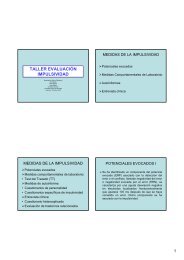Abstract Objectives: To analyze the comorbidity of Pathological Gamblers, mainly in disor<strong>de</strong>rs with loss of impulse- control as Addictions and Personality Disor<strong>de</strong>rs (PD). Also, to discuss about the addictive and impulsive characteristics of Pathological Gambling (PG), and their implications in prognosis and treatment. Material and Methods: Cross-sectional study on 162 patients with PG admitted in for treatment in a specific resi<strong>de</strong>ntial unit. The SCID-I and II were used for the addiction and the PD diagnosis. For the diagnosis and evaluation of PG the SOGS, AGQ III and the Gambling Severity In<strong>de</strong>x were also used. Results: The 61,1% of the patients presented some PD, where the Cluster B ones (impulsive group) were more frequent, followed by C and A ones. 63,3% of patients had had in their lives substance <strong>de</strong>pen<strong>de</strong>nce criteria, where alcohol <strong>de</strong>pen<strong>de</strong>nce was the most prevalent. The presence of PD is related to the gravity of the addiction by the <strong>de</strong>pen<strong>de</strong>nce to more than one substance (X 2 =7,15;p
Introducción La Ludopatía es un trastorno mental que cada vez está cobrando más interés entre los clínicos 1,2 . La inci<strong>de</strong>ncia <strong>de</strong> esta enfermedad según el DSM-IV se sitúa entre el 1% y el 3% <strong>de</strong> la población general 3 . En Europa cabe <strong>de</strong>stacar a España como el país que tiene un mayor gasto “per cápita”, sirva como ejemplo una Lotería Nacional nacida en 1812, pero don<strong>de</strong> las máquinas recreativas con premio suponen el 42,6% <strong>de</strong>l gasto en juego, seguidas con un gasto <strong>de</strong>l 21,7% en los bingos 4 . Este dato es preocupante pues algunos autores como Lesieur o McCormick, citados por González en 1996 5 , observaron un incremento <strong>de</strong> la Ludopatía paralelo al gasto en juego legalizado. Sin embargo es EEUU el país que más estudios epi<strong>de</strong>miológicos ha realizado sobre este trastorno. El primer estudio se realizó en 1974 cuando se observó que el 0,77% <strong>de</strong> la población eran probables jugadores patológicos y el 2,33% potenciales 6 , en estudios más sistematizados estos porcentajes aumentaban al 2,5%-3,4% y 3,4%-4,1% respectivamente 7,8 . Estudios posteriores, utilizando la South Oaks Gambling Screening (SOGS), apuntan a un 1,2%-1,5% <strong>de</strong> probables jugadores patológicos 9,10 . Un reciente meta-análisis, realizado en EEUU y Canadá, apunta a una inci<strong>de</strong>ncia a lo largo <strong>de</strong> la vida <strong>de</strong>l 1,6% 11 . En España, varios estudios que ha utilizado instrumentos cuantitativos semejantes han estimado una prevalencia entre un 1,36% y un 1,91% <strong>de</strong> ludópatas en población general 12-15 . De igual modo, habrá que estar pendiente <strong>de</strong> los resultados que se obtengan en un futuro con técnicas cualitativas ya en <strong>de</strong>sarrollo 16 . En cuanto a las características socio<strong>de</strong>mográficas <strong>de</strong> estos pacientes, la mayoría <strong>de</strong> autores apuntan a una enfermedad <strong>de</strong> predominio en varones, <strong>de</strong>s<strong>de</strong> una proporción <strong>de</strong> 3:1 15 hasta llegar a una <strong>de</strong> 9:1 1,17-18 . Respecto a la edad, <strong>de</strong>stacar que es una enfermedad <strong>de</strong> comienzo en la adolescencia o en adultos jóvenes 1 , don<strong>de</strong> estudios recientes han <strong>de</strong>mostrado que la prevalencia <strong>de</strong> jugadores patológicos en menores <strong>de</strong> 18 años se estima entre el 2,9% 17 y el 5,4% 19 . Una repercusión importante <strong>de</strong>l comienzo temprano <strong>de</strong> esta patología es el absentismo escolar 20 . En los menores <strong>de</strong> 18 años, a<strong>de</strong>más se ha objetivado una importante relación con el consumo <strong>de</strong> sustancias, ya que hasta el 14,3% <strong>de</strong> los jugadores patológicos consumían tabaco y/o alcohol, muy por encima <strong>de</strong> la media poblacional <strong>de</strong> la misma edad 19 . La Ludopatía es consi<strong>de</strong>rada por la OMS y la APA como un trastorno <strong>de</strong>l control <strong>de</strong> los impulsos (TCI), pues el individuo que pa<strong>de</strong>ce este trastorno se va haciendo <strong>de</strong> forma crónica y progresiva incapaz <strong>de</strong> resistir el impulso <strong>de</strong> jugar 1 . A<strong>de</strong>más es frecuente que los ludópatas presenten a<strong>de</strong>más otros TCI comórbidos 21-22 . Aunque inicialmente fue propuesto como un trastorno <strong>de</strong>l ánimo, parece que esta opción está actualmente <strong>de</strong>scartada 23 . Sin embargo otros autores consi<strong>de</strong>ran a este trastorno más próximo a los TUS 1 . En cualquier caso, la comorbilidad entre los TCI y los TUS, así como con los TP, son una constante <strong>de</strong> la práctica clínica y con frecuencia cuestiona el carácter in<strong>de</strong>pendiente <strong>de</strong>rivado <strong>de</strong> su clasificación como entida<strong>de</strong>s separadas 24 . En esta línea múltiples investigaciones 25-30 , y una reciente revisión 24 , han <strong>de</strong>terminado varios aspectos ambientales, psicológicos y biológicos comunes, entre los que <strong>de</strong>staca la dimensión impulsiva <strong>de</strong> la ______________ Esto es un pre-print <strong>de</strong> un artículo y está sujeto a cambios <strong>de</strong>spués <strong>de</strong> la publicación. Originalmente Publicado en: Krue<strong>de</strong>lbach N, Walker HI, Chapman HA, Haro G, Mateu C, Leal C. Comorbilidad <strong>de</strong> trastornos con pérdida <strong>de</strong>l control <strong>de</strong> impulsos: Ludopatía, Adicciones y Trastornos <strong>de</strong> la Personalidad. <strong>Actas</strong> <strong>Españolas</strong> <strong>de</strong> <strong>Psiquiatría</strong> <strong>2006</strong>;<strong>34</strong>(2):<strong>76</strong>-<strong>82</strong>.



